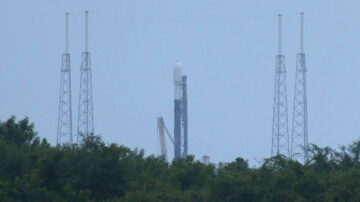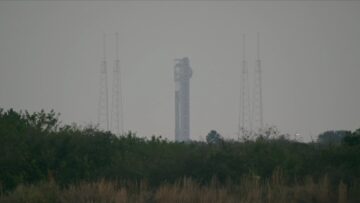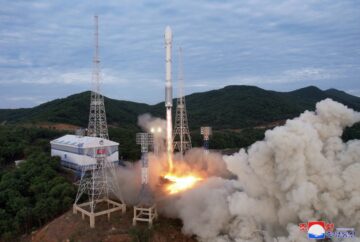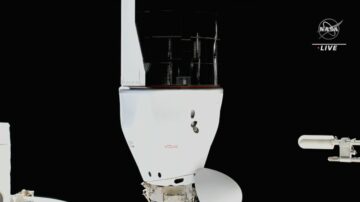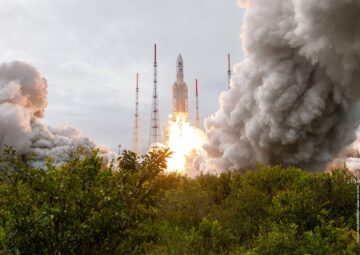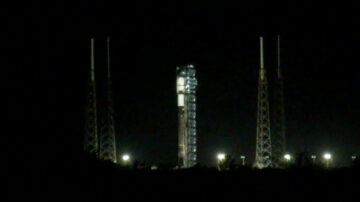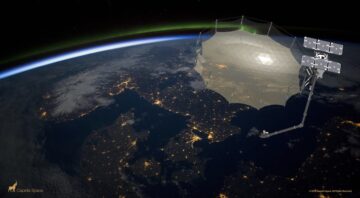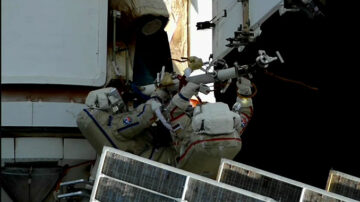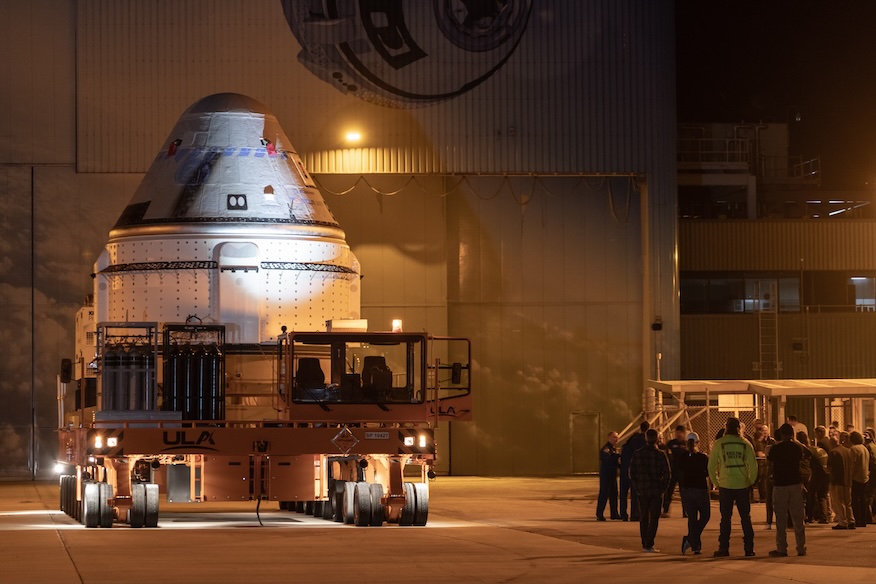
Update 10:41 a.m. EDT: Added additional timing information regarding work at the VIF and a statement from Boeing regarding the Starliner-1 crew makeup.
Boeing’s CST-100 Starliner embarked on its last big road trip before its journey to the International Space Station next month. In the pre-dawn hours of Tuesday morning, the capsule and its service module made the slow trek from Kennedy Space Center to Space Launch Complex 41 on Cape Canaveral Space Force Station.
The rollout of the vehicle, named Calypso, is another key step towards the Crew Flight Test (CFT) of the Starliner spacecraft, the first time that it will carry astronauts to and from the ISS. The mission’s crew, NASA astronauts Butch Wilmore and Suni Williams, were on hand to witness the departure of their ticket to ride.
“Big day for our nation. Big day for NASA. Big day for Boeing as we get over to the rocket and mate these things together,” said Wilmore, the CFT commander. “We’re excited to be here at this point, early in the morning, and excited that you came to share the experience with us. So, go Starliner!”
The journey from the Commercial Crew and Cargo Processing Facility (C3PF) was a slow and steady process. The doors of the Commercial Crew and Cargo Processing Facility (C3PF) opened around 4 a.m. EDT (0800 UTC).
Before @BoeingSpace Starliner departed the vicinity of the Commercial Crew and Cargo Processing Facility (C3PF), Crew Flight Test Commander Butch Wilmore and Pilot @Astro_Suni addressed the press about the rollout of the spacecraft that they will ride up to the International… pic.twitter.com/fAX1lrss2L
— Spaceflight Now (@SpaceflightNow) April 16, 2024
The transport vehicle, provided by United Launch Alliance (ULA), left the parking lot of the C3PF right around 5 a.m. EDT (0900 UTC) and headed towards Space Launch Complex 41, where an Atlas 5 rocket stood waiting for it. It was waved off by a group of ULA, Boeing and NASA employees who helped get the spacecraft to the point where it was ready to ferry astronauts.
“We were super proud of this team. You see all these people who came out this morning,” said Williams, gesturing to the crowd gathered alongside the security fence of the C3PF. “They made it happen and it’s time to turn over from production to operation. We’re ready to take it flying. We’re ready.”
After the spacecraft arrived at SLC-41 around 6 a.m. EDT (1000 UTC), crews began the process of lifting it atop the Atlas 5 rocket around 9 a.m. EDT (1300 UTC) to integrate with the vehicle inside the Vertical Integration Facility (VIF).
Last Thursday, Mark Sorensen, the Starliner CFT Crew Module lead, spoke with Spaceflight Now about reaching this milestone. He said it was a very gratifying moment for him and the team to finally be at this point.
“A lot of work to get there. It’s been two years since we’ve last done this and for all the right reasons. We’ve taken our time, make sure we had it right,” Sorensen said. “ The team is very excited. This will be the first time we fly crew, which is what we’re all about.”
Preparing for debut
Moving Calypso out of the C3PF came after a couple of weeks of fueling, which included loading the three different kinds of propellant. The crew module uses hydrazine as its single propellant alongside catalyst beds in the thrusters. The service module uses a combination of nitrogen tetroxide and monomethylhydrazine.
Sorensen said they begin with fueling the crew module, which includes monitoring pressures and fuel levels throughout the process.
“We’re very deliberate, as you say, and that’s typical of spacecraft or satellites as well. We take our time with that,” Sorensen said. “In a launch vehicle, you’re much more rushed, right? You have your launch count you gotta meet. You got to get the [cryogenic propellants] on there and they’ve got a very short time where you can deal with those.
“We have a lot more time. Because of that, we take more time so that we get it right.”

He noted that they also did some late cargo loading while inside the C3PF, which was originally going to have to wait until they arrived at the VIF.
“We’re going to go over to the VIF and the launch vehicle integration phase very clean, as clean as we’ve ever been,” Sorensen said. “So, it should make that part of the flow very easy. That’s good because we are going to do more crew training.”
Sorensen said due to some of the abort scenarios for the spacecraft they “did a couple of little late cargo moves, adding a little bit of extra weight” to ensure they had the right center of gravity.
One of the last steps taken before the spacecraft was loaded up on its ULA-provided transport was testing the center of gravity and getting an exact weight on the capsule and service module using Boeing’s weight and center-of-gravity (weight and CG) stand. Those measurements were taken on Monday.
“Our center of gravity is very important to us. We have to have it fit inside the size of a quarter. So we have to know that very exactly,” Sorensen said.
Once the spacecraft is hoisted atop the Atlas 5 rocket, he said they will attach the roughly 130 bolts that keep things together. Once ULA is able to grant the Boeing team access to the spacecraft once again, they begin a series of interface checkouts.
“We have to load the ground coolant onto the vehicle, make sure we can cool it. We have to electrically hook up between us and the launch vehicle. Then we’ll power up the vehicle and validate both our vehicles’ performance,” Sorensen said. “And then, ULA will measure their performance and then we’ll talk to each other, make sure the emergency abort systems are all talking to each other, giving the right information.”
The #AtlasV will receive its precious cargo today as the @BoeingSpace #Starliner spacecraft is transported to ULA’s Vertical Integration Facility and lifted onto the rocket.
Launch of the Crew Flight Test (#CFT) is NET May 6 https://t.co/yCCjHu9R5K pic.twitter.com/UJvPnVB2CT
— ULA (@ulalaunch) April 16, 2024
Sorensen said that will be followed by an end-to-end test with the Mission Control Center in Houston, Texas, in the loop. Finally, they will add the last bit of cargo and close out the vehicle.
“And we hand it really over to the mission team, which is a separate team that’s run by Tim Reith, our Mission Integration and Operations team. And they’ll take it from there,” he said. “Then they go run that mission piece, which includes this dry run with the crew and then rollout to the pad and then all of the launch day activities, they manage.”
Sorensen said it’s been a gratifying full circle moment in his career to go from helping to build the space station as part of the Boeing team to now facilitating the latests spacecraft that will bring astronauts to it. He said getting through the CFT might be the swan song of his career.
“I haven’t really quite figured that out, but I am on the cusp of retirement and this was one of my principle goals, to get through CFT,” Sorensen said. “So, we’re looking at that. I’ll help the program make sure the vehicle gets back and make sure it’s safe and we understand everything that we got back. And then, I’ll always avail myself to them, but I’m kind of looking at retirement myself.”
Glimpse of the future
During the rollout operations on Tuesday morning, Wilmore and Williams weren’t the only astronauts on hand. Among the crowd of Boeing, ULA and NASA employees were the astronauts who make up the crew of the Starliner-1 mission, the first crew rotation flight set to launch no earlier than spring 2025.
Commander Scott Tingle was joined for several photos by fellow NASA astronaut and Starliner-1 Pilot Mike Fincke as well as Canadian Space Agency (CSA) astronaut and Mission Specialist 1 Joshua Kutryk.
That trio was joined by Japanese Aerospace Exploration Agency (JAXA) astronaut Kimiya Yui. To date, neither NASA nor Boeing have confirmed he holds the Mission Specialist 2 position on the Starliner-1 flight, however, according to his bio on the JAXA website, he was assigned to a long-duration mission in June 2023, which as of November 2023 “was rescheduled for 2025.”
Yui, who previously flew aboard the ISS as part of Expeditions 44 and 45 in 2015, also posted to his social media noting his forthcoming mission in 2025 and created a number of posts about his Starliner training.
皆さん、こんにちは!
今日は、Starliner宇宙船の有人テスト飛行へ向けた訓練を、管制官側から見学させて頂きました。自分達の訓練では、地上の動きは直接見ることはできないので、とても良い勉強になりました。— 油井 亀美也 Kimiya.Yui (@Astro_Kimiya) April 5, 2024
Amid the rollout event, Tingle shared a photo of himself alongside Fincke, Kutryk and Yui in front of the Starliner spacecraft, further suggesting that this could be the team to next fly aboard the spacecraft in about a year. However, in a statement to Spaceflight Now, a Boeing spokesperson said that the fourth member of the Starliner-1 mission hasn’t been finalized.
“We always welcome NASA and international partners when they want to see the latest progress on Starliner and check out one of their potential future rides to space,” the spokesperson said.
Huge milestone this morning. Starliner rolled over from Boeing to ULA for integration to the launch vehicle. Great work Boeing, ULA, NASA!!! Starliner Crew Flight Test launch May 6th!! Fly Team Starliner!! pic.twitter.com/ZTmq0XXF4v
— Scott Tingle (@Astro_Maker1) April 16, 2024
- SEO Powered Content & PR Distribution. Get Amplified Today.
- PlatoData.Network Vertical Generative Ai. Empower Yourself. Access Here.
- PlatoAiStream. Web3 Intelligence. Knowledge Amplified. Access Here.
- PlatoESG. Carbon, CleanTech, Energy, Environment, Solar, Waste Management. Access Here.
- PlatoHealth. Biotech and Clinical Trials Intelligence. Access Here.
- Source: https://spaceflightnow.com/2024/04/16/boeing-ula-roll-starliner-spacecraft-out-to-pad-41-ahead-of-crew-flight-test-launch-in-may/
- :is
- :where
- $UP
- 1
- 10
- 11
- 130
- 1300
- 16
- 2%
- 2015
- 2023
- 2024
- 2025
- 4
- 41
- 45
- 5
- 6
- 9
- a
- Able
- About
- access
- According
- activities
- Adam
- add
- added
- adding
- Additional
- addressed
- Aerospace
- After
- again
- agency
- ahead
- All
- Alliance
- alongside
- also
- always
- am
- among
- an
- and
- Another
- April
- ARE
- AREA
- around
- arrived
- AS
- assigned
- astronaut
- At
- atlas
- attach
- avail
- back
- BE
- because
- been
- before
- began
- begin
- being
- between
- Big
- bio
- Bit
- Boeing
- both
- bring
- build
- but
- butch
- by
- came
- CAN
- Canadian
- cape
- Career
- Cargo
- carry
- Catalyst
- Center
- check
- Circle
- clean
- Close
- combination
- commercial
- complex
- CONFIRMED
- control
- Cool
- could
- count
- Couple
- created
- crew
- crowd
- cryogenic
- Cusp
- Date
- day
- deal
- DID
- different
- do
- done
- doors
- dry
- due
- each
- Earlier
- Early
- easy
- embarked
- embarks
- emergency
- employees
- end-to-end
- ensure
- Event
- EVER
- everything
- exact
- exactly
- excited
- experience
- exploration
- extra
- facilitating
- Facility
- fellow
- fence
- figured
- final
- finalized
- Finally
- First
- first time
- fit
- flight
- flow
- flying
- followed
- For
- Force
- forthcoming
- Fourth
- from
- front
- Fuel
- fueling
- full
- further
- future
- gathered
- get
- gets
- getting
- Giving
- Go
- Goals
- going
- good
- got
- grant
- gravity
- great
- Ground
- Group
- had
- hand
- happen
- Have
- he
- headed
- help
- helped
- helping
- here
- High
- him
- himself
- his
- holds
- HOURS
- houston
- However
- http
- HTTPS
- i
- I’LL
- image
- important
- in
- included
- includes
- information
- inside
- integrate
- integration
- Interface
- International
- international space station
- ISS
- IT
- ITS
- Japanese
- joined
- joshua
- journey
- jpg
- june
- Keep
- Key
- Kind
- kinds
- Know
- Last
- Late
- latest
- launch
- lead
- left
- levels
- Lifted
- lifting
- little
- load
- loading
- looking
- Lot
- made
- make
- makeup
- manage
- mark
- mate
- max-width
- May..
- measure
- measurements
- Media
- Meet
- member
- might
- mike
- milestone
- Mission
- Mission Control
- module
- moment
- Monday
- monitoring
- Month
- more
- morning
- moves
- much
- my
- myself
- Named
- Nasa
- nation
- Neither
- net
- next
- no
- nor
- noted
- noting
- November
- now
- number
- of
- off
- on
- once
- ONE
- only
- onto
- opened
- operation
- Operations
- or
- originally
- Other
- our
- out
- over
- pad
- parking
- part
- partners
- People
- performance
- phase
- photo
- Photos
- piece
- pilot
- plato
- Plato Data Intelligence
- PlatoData
- Point
- position
- positioned
- posted
- Posts
- potential
- power
- Precious
- press
- pressures
- previously
- principle
- process
- processing
- Production
- Program
- Progress
- proud
- provided
- Quarter
- quite
- reaching
- ready
- really
- reasons
- receive
- regarding
- retirement
- Ride
- rides
- right
- road
- rocket
- Roll
- Rolled
- Rolling
- rollout
- roughly
- Run
- rushed
- s
- safe
- Said
- satellites
- say
- scenarios
- scott
- security
- see
- separate
- Series
- service
- set
- several
- Share
- shared
- Short
- should
- since
- single
- Size
- slow
- So
- Social
- social media
- some
- song
- Space
- Space Force
- space station
- spacecraft
- spaceflight
- specialist
- spokesperson
- spring
- stand
- Statement
- station
- steady
- Step
- Steps
- stood
- Super
- sure
- swan
- Systems
- Take
- taken
- Talk
- talking
- team
- test
- Testing
- tests
- texas
- than
- that
- The
- the security
- their
- Them
- then
- There.
- These
- they
- things
- this
- those
- three
- Through
- throughout
- thursday
- ticket
- Ticket to Ride
- Tim
- time
- timing
- to
- today
- together
- towards
- Training
- transport
- transported
- trio
- trip
- true
- Tuesday
- TURN
- two
- typical
- understand
- United
- until
- us
- uses
- using
- UTC
- VALIDATE
- vehicle
- vertical
- very
- wait
- Waiting
- want
- was
- we
- Website
- Weeks
- weight
- welcome
- WELL
- were
- What
- when
- which
- while
- WHO
- will
- Williams
- with
- witness
- Work
- year
- years
- you
- Your
- zephyrnet

